Risk Management: Determining and Managing Risk Exposure Strategies
VerifiedAdded on 2023/01/12
|10
|2296
|43
Report
AI Summary
This report comprehensively addresses the determination and management of risk exposure strategies. It begins by establishing the basis for risk acceptance and rejection criteria and outlines the eleven principles of risk management. The report delves into actuarial analysis and provides a list of tools used to measure benchmarks. It identifies various business risk elements, information sources, and relevant legislation, including insurance contracts, privacy, and consumer protection. The report explores mitigating capabilities, organizational factors impacting risk acceptability, and necessary organizational information. It further examines factors influencing risk acceptability, governance structures, and terms for high-risk factors. The report details the documentation of risk assessment strategies, methods for collecting feedback, and the use of Work Breakdown Structures (WBS). It also describes resource categories, action plan information, and the process for developing a communication plan. Finally, the report emphasizes the importance of monitoring and evaluating risk acceptance strategies, documenting review and evaluation results, and provides a list of references.
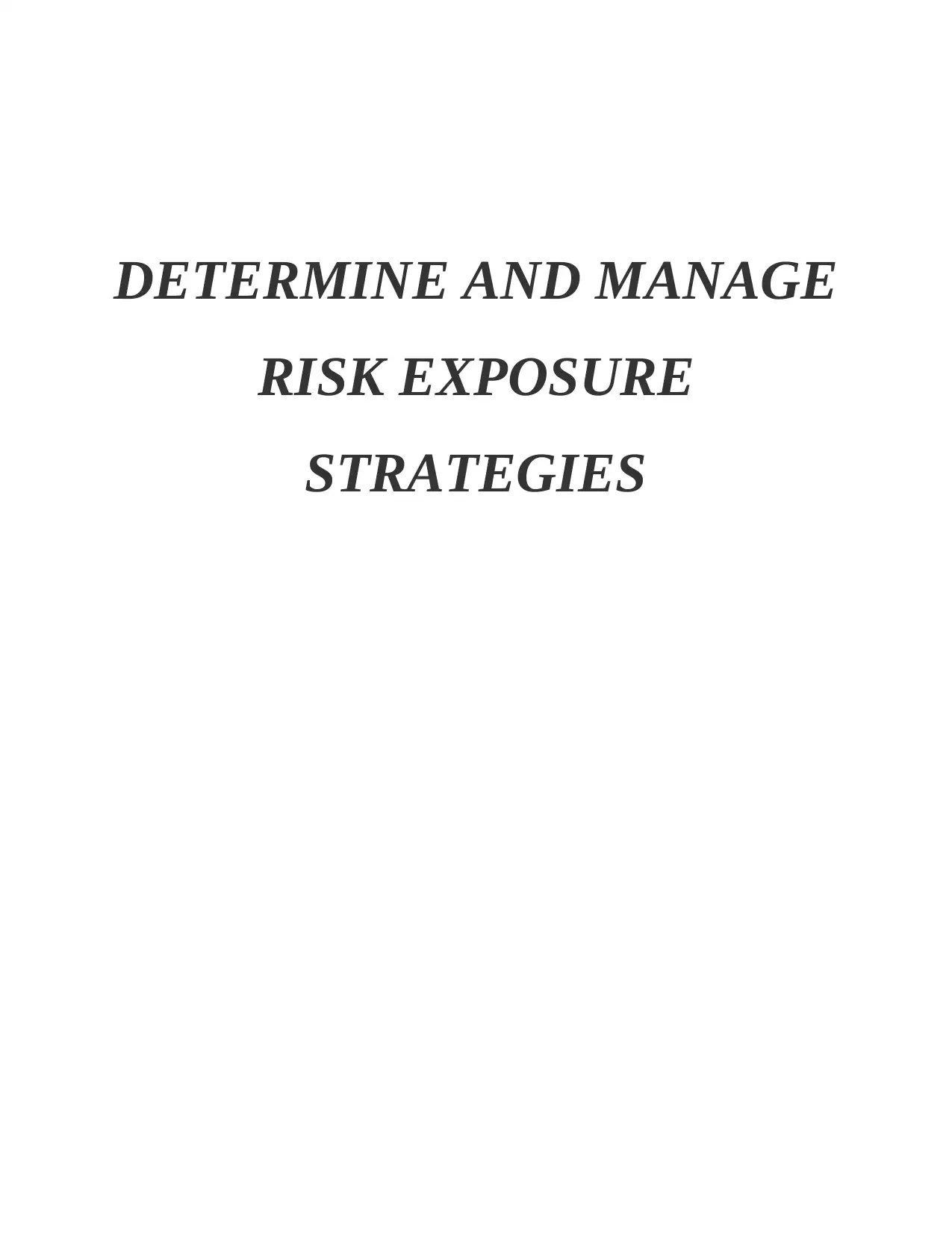
DETERMINE AND MANAGE
RISK EXPOSURE
STRATEGIES
RISK EXPOSURE
STRATEGIES
Paraphrase This Document
Need a fresh take? Get an instant paraphrase of this document with our AI Paraphraser
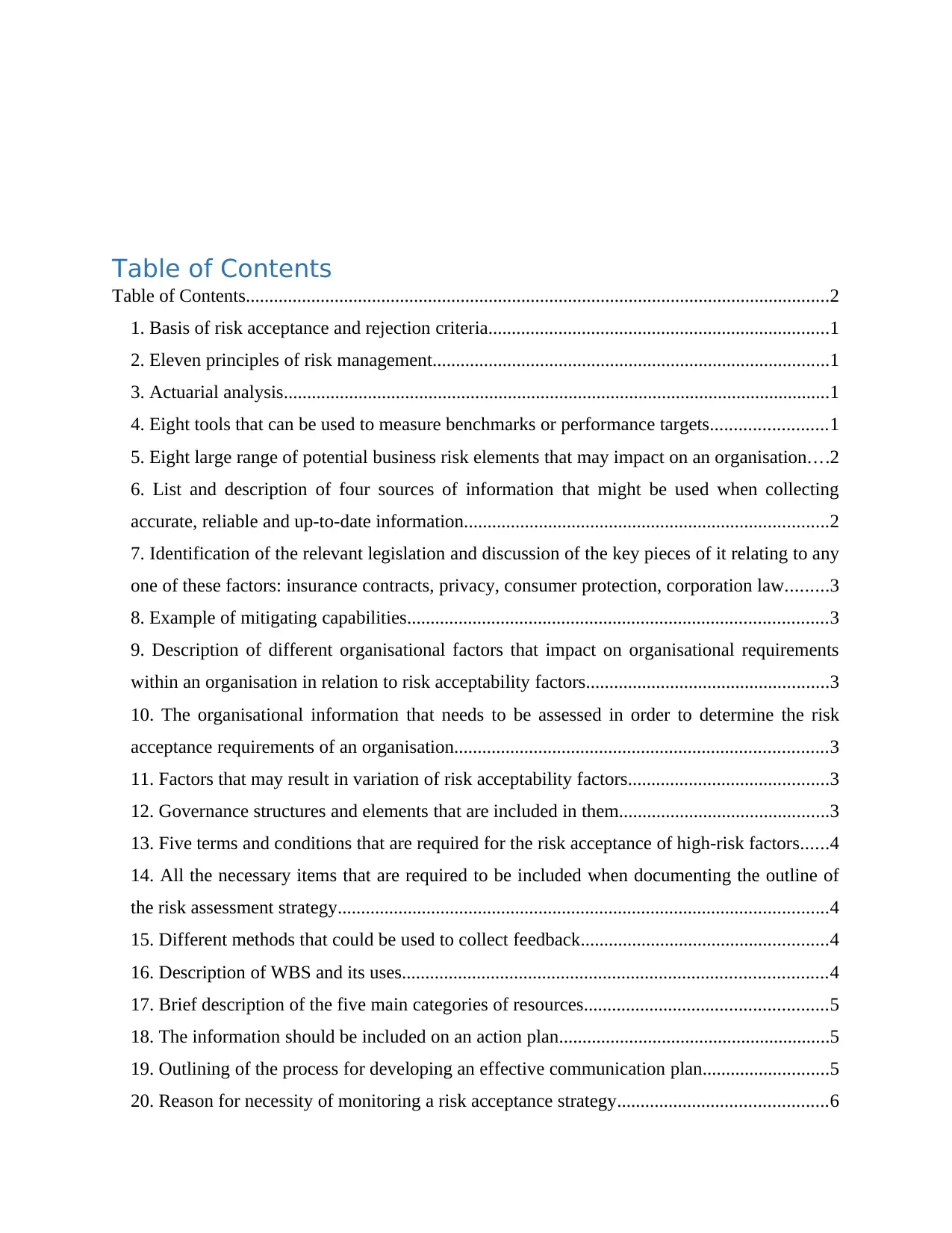
Table of Contents
Table of Contents.............................................................................................................................2
1. Basis of risk acceptance and rejection criteria.........................................................................1
2. Eleven principles of risk management.....................................................................................1
3. Actuarial analysis.....................................................................................................................1
4. Eight tools that can be used to measure benchmarks or performance targets.........................1
5. Eight large range of potential business risk elements that may impact on an organisation....2
6. List and description of four sources of information that might be used when collecting
accurate, reliable and up-to-date information..............................................................................2
7. Identification of the relevant legislation and discussion of the key pieces of it relating to any
one of these factors: insurance contracts, privacy, consumer protection, corporation law.........3
8. Example of mitigating capabilities..........................................................................................3
9. Description of different organisational factors that impact on organisational requirements
within an organisation in relation to risk acceptability factors....................................................3
10. The organisational information that needs to be assessed in order to determine the risk
acceptance requirements of an organisation................................................................................3
11. Factors that may result in variation of risk acceptability factors...........................................3
12. Governance structures and elements that are included in them.............................................3
13. Five terms and conditions that are required for the risk acceptance of high-risk factors......4
14. All the necessary items that are required to be included when documenting the outline of
the risk assessment strategy.........................................................................................................4
15. Different methods that could be used to collect feedback.....................................................4
16. Description of WBS and its uses...........................................................................................4
17. Brief description of the five main categories of resources....................................................5
18. The information should be included on an action plan..........................................................5
19. Outlining of the process for developing an effective communication plan...........................5
20. Reason for necessity of monitoring a risk acceptance strategy.............................................6
Table of Contents.............................................................................................................................2
1. Basis of risk acceptance and rejection criteria.........................................................................1
2. Eleven principles of risk management.....................................................................................1
3. Actuarial analysis.....................................................................................................................1
4. Eight tools that can be used to measure benchmarks or performance targets.........................1
5. Eight large range of potential business risk elements that may impact on an organisation....2
6. List and description of four sources of information that might be used when collecting
accurate, reliable and up-to-date information..............................................................................2
7. Identification of the relevant legislation and discussion of the key pieces of it relating to any
one of these factors: insurance contracts, privacy, consumer protection, corporation law.........3
8. Example of mitigating capabilities..........................................................................................3
9. Description of different organisational factors that impact on organisational requirements
within an organisation in relation to risk acceptability factors....................................................3
10. The organisational information that needs to be assessed in order to determine the risk
acceptance requirements of an organisation................................................................................3
11. Factors that may result in variation of risk acceptability factors...........................................3
12. Governance structures and elements that are included in them.............................................3
13. Five terms and conditions that are required for the risk acceptance of high-risk factors......4
14. All the necessary items that are required to be included when documenting the outline of
the risk assessment strategy.........................................................................................................4
15. Different methods that could be used to collect feedback.....................................................4
16. Description of WBS and its uses...........................................................................................4
17. Brief description of the five main categories of resources....................................................5
18. The information should be included on an action plan..........................................................5
19. Outlining of the process for developing an effective communication plan...........................5
20. Reason for necessity of monitoring a risk acceptance strategy.............................................6
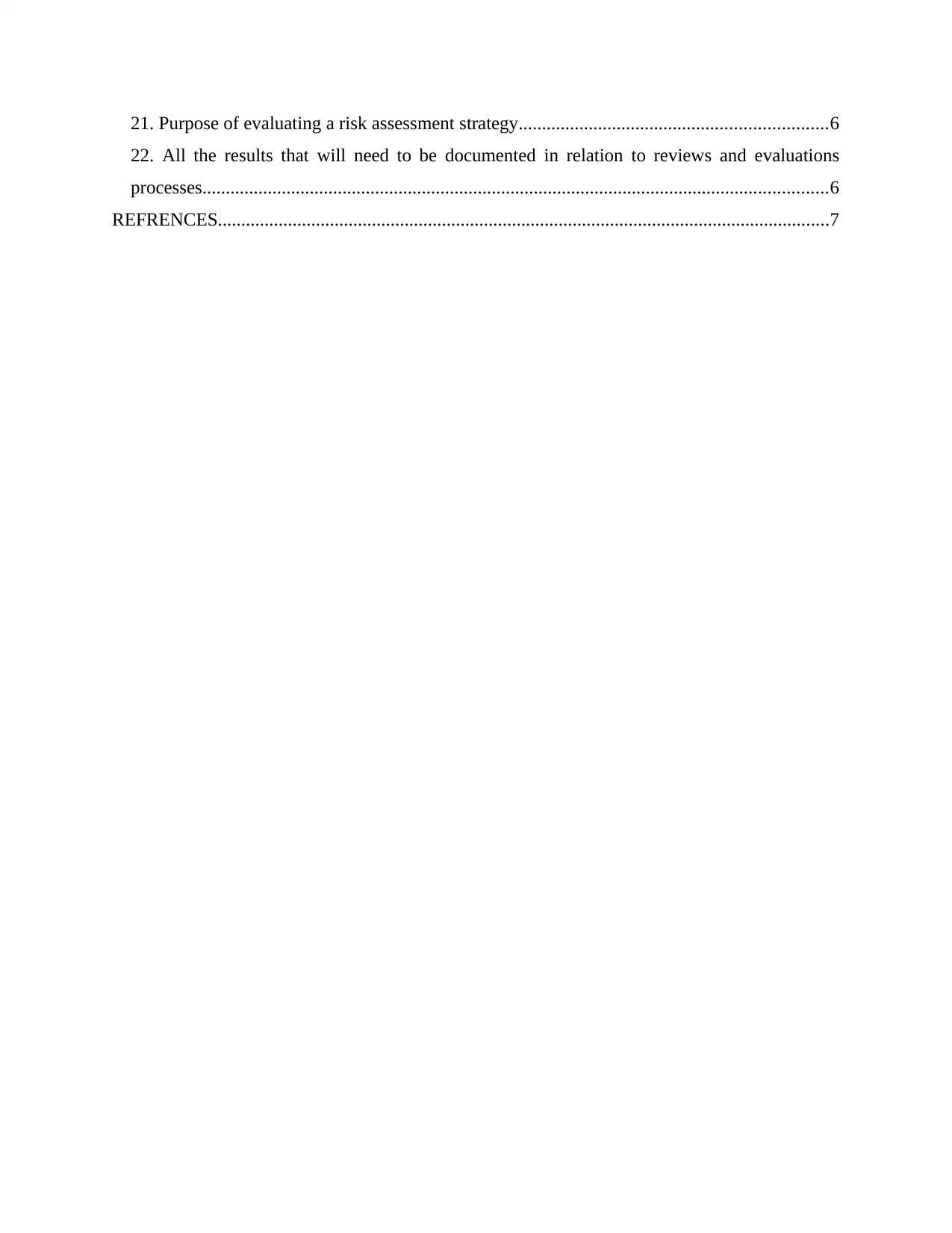
21. Purpose of evaluating a risk assessment strategy..................................................................6
22. All the results that will need to be documented in relation to reviews and evaluations
processes......................................................................................................................................6
REFRENCES...................................................................................................................................7
22. All the results that will need to be documented in relation to reviews and evaluations
processes......................................................................................................................................6
REFRENCES...................................................................................................................................7
⊘ This is a preview!⊘
Do you want full access?
Subscribe today to unlock all pages.

Trusted by 1+ million students worldwide
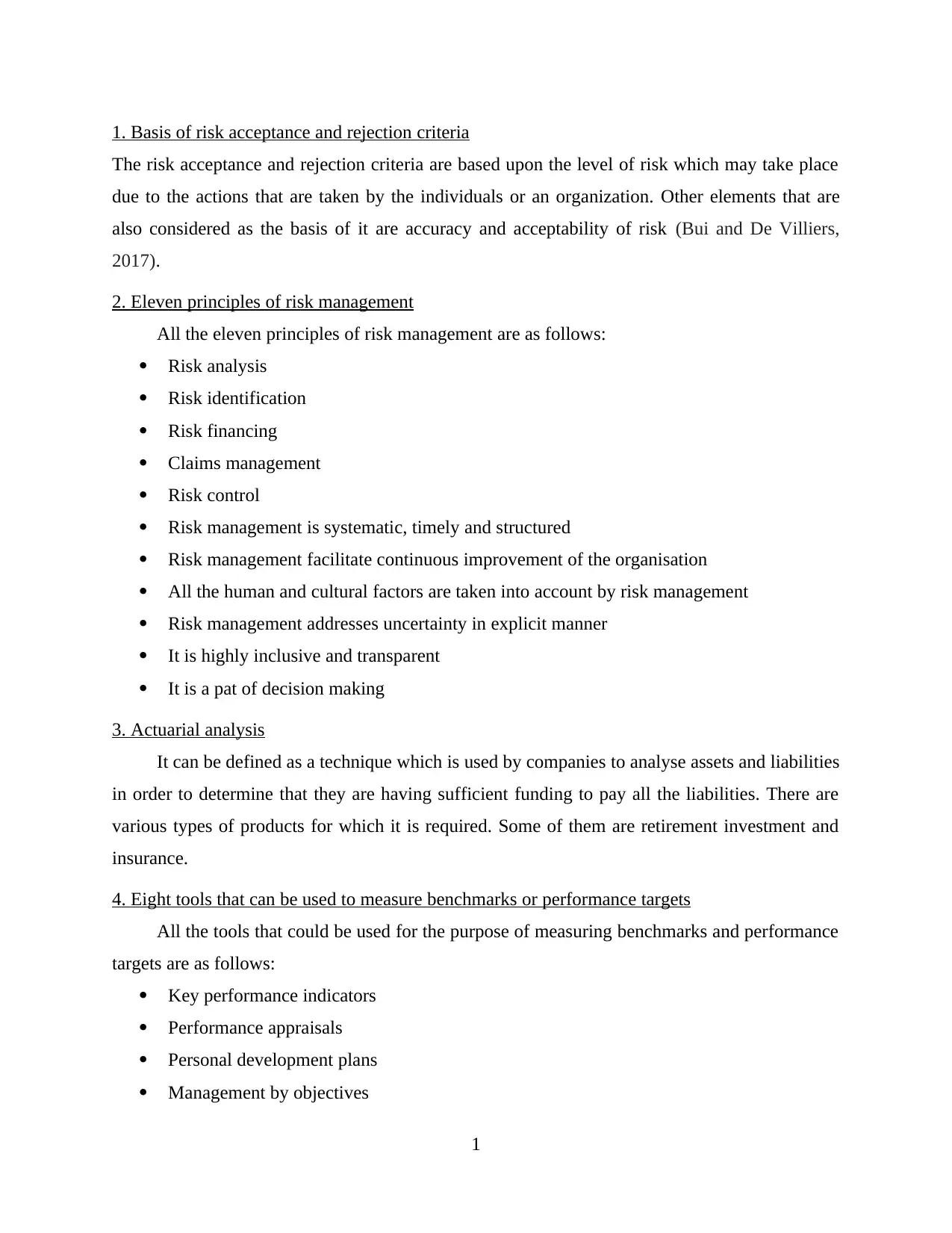
1. Basis of risk acceptance and rejection criteria
The risk acceptance and rejection criteria are based upon the level of risk which may take place
due to the actions that are taken by the individuals or an organization. Other elements that are
also considered as the basis of it are accuracy and acceptability of risk (Bui and De Villiers,
2017).
2. Eleven principles of risk management
All the eleven principles of risk management are as follows:
Risk analysis
Risk identification
Risk financing
Claims management
Risk control
Risk management is systematic, timely and structured
Risk management facilitate continuous improvement of the organisation
All the human and cultural factors are taken into account by risk management
Risk management addresses uncertainty in explicit manner
It is highly inclusive and transparent
It is a pat of decision making
3. Actuarial analysis
It can be defined as a technique which is used by companies to analyse assets and liabilities
in order to determine that they are having sufficient funding to pay all the liabilities. There are
various types of products for which it is required. Some of them are retirement investment and
insurance.
4. Eight tools that can be used to measure benchmarks or performance targets
All the tools that could be used for the purpose of measuring benchmarks and performance
targets are as follows:
Key performance indicators
Performance appraisals
Personal development plans
Management by objectives
1
The risk acceptance and rejection criteria are based upon the level of risk which may take place
due to the actions that are taken by the individuals or an organization. Other elements that are
also considered as the basis of it are accuracy and acceptability of risk (Bui and De Villiers,
2017).
2. Eleven principles of risk management
All the eleven principles of risk management are as follows:
Risk analysis
Risk identification
Risk financing
Claims management
Risk control
Risk management is systematic, timely and structured
Risk management facilitate continuous improvement of the organisation
All the human and cultural factors are taken into account by risk management
Risk management addresses uncertainty in explicit manner
It is highly inclusive and transparent
It is a pat of decision making
3. Actuarial analysis
It can be defined as a technique which is used by companies to analyse assets and liabilities
in order to determine that they are having sufficient funding to pay all the liabilities. There are
various types of products for which it is required. Some of them are retirement investment and
insurance.
4. Eight tools that can be used to measure benchmarks or performance targets
All the tools that could be used for the purpose of measuring benchmarks and performance
targets are as follows:
Key performance indicators
Performance appraisals
Personal development plans
Management by objectives
1
Paraphrase This Document
Need a fresh take? Get an instant paraphrase of this document with our AI Paraphraser
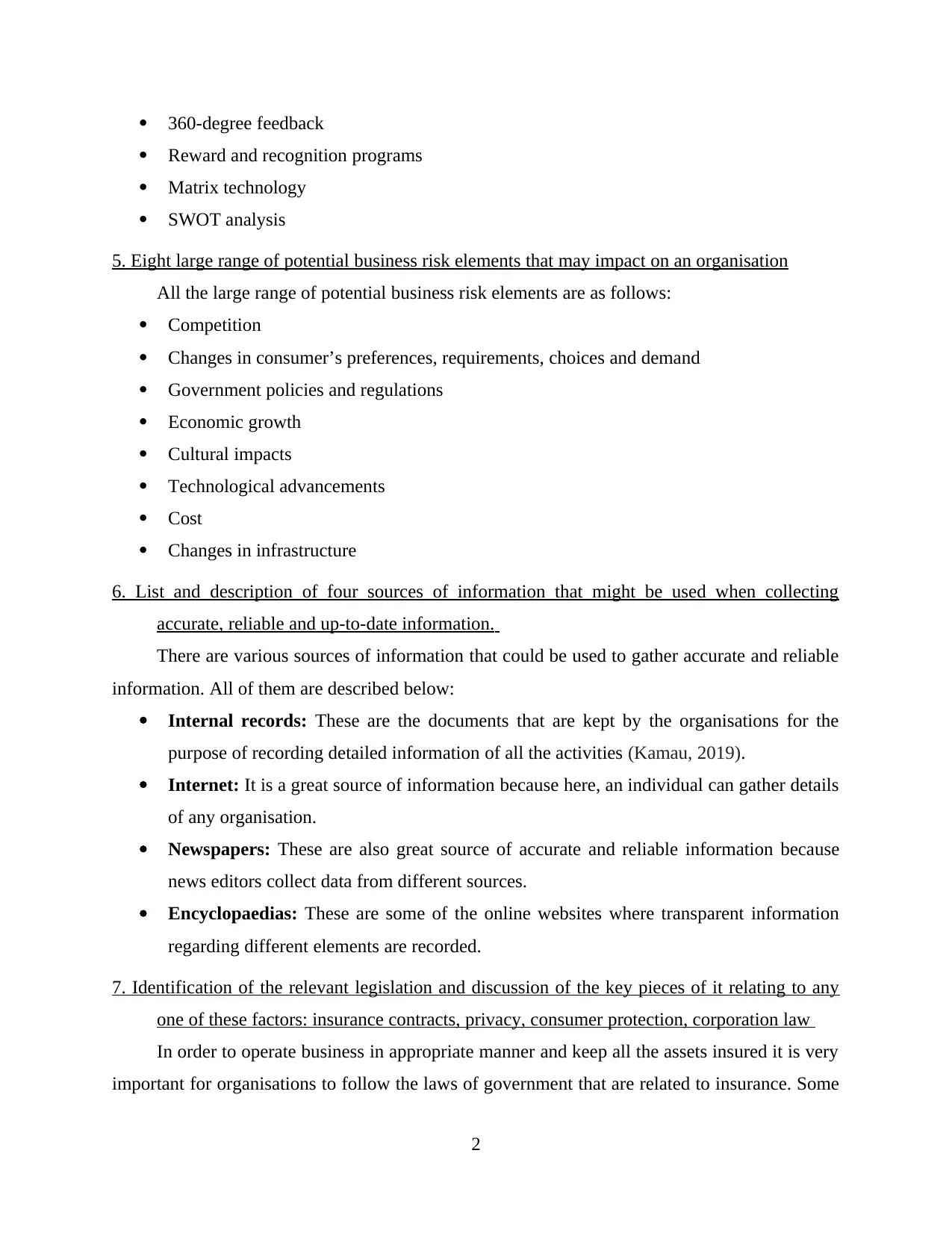
360-degree feedback
Reward and recognition programs
Matrix technology
SWOT analysis
5. Eight large range of potential business risk elements that may impact on an organisation
All the large range of potential business risk elements are as follows:
Competition
Changes in consumer’s preferences, requirements, choices and demand
Government policies and regulations
Economic growth
Cultural impacts
Technological advancements
Cost
Changes in infrastructure
6. List and description of four sources of information that might be used when collecting
accurate, reliable and up-to-date information.
There are various sources of information that could be used to gather accurate and reliable
information. All of them are described below:
Internal records: These are the documents that are kept by the organisations for the
purpose of recording detailed information of all the activities (Kamau, 2019).
Internet: It is a great source of information because here, an individual can gather details
of any organisation.
Newspapers: These are also great source of accurate and reliable information because
news editors collect data from different sources.
Encyclopaedias: These are some of the online websites where transparent information
regarding different elements are recorded.
7. Identification of the relevant legislation and discussion of the key pieces of it relating to any
one of these factors: insurance contracts, privacy, consumer protection, corporation law
In order to operate business in appropriate manner and keep all the assets insured it is very
important for organisations to follow the laws of government that are related to insurance. Some
2
Reward and recognition programs
Matrix technology
SWOT analysis
5. Eight large range of potential business risk elements that may impact on an organisation
All the large range of potential business risk elements are as follows:
Competition
Changes in consumer’s preferences, requirements, choices and demand
Government policies and regulations
Economic growth
Cultural impacts
Technological advancements
Cost
Changes in infrastructure
6. List and description of four sources of information that might be used when collecting
accurate, reliable and up-to-date information.
There are various sources of information that could be used to gather accurate and reliable
information. All of them are described below:
Internal records: These are the documents that are kept by the organisations for the
purpose of recording detailed information of all the activities (Kamau, 2019).
Internet: It is a great source of information because here, an individual can gather details
of any organisation.
Newspapers: These are also great source of accurate and reliable information because
news editors collect data from different sources.
Encyclopaedias: These are some of the online websites where transparent information
regarding different elements are recorded.
7. Identification of the relevant legislation and discussion of the key pieces of it relating to any
one of these factors: insurance contracts, privacy, consumer protection, corporation law
In order to operate business in appropriate manner and keep all the assets insured it is very
important for organisations to follow the laws of government that are related to insurance. Some
2
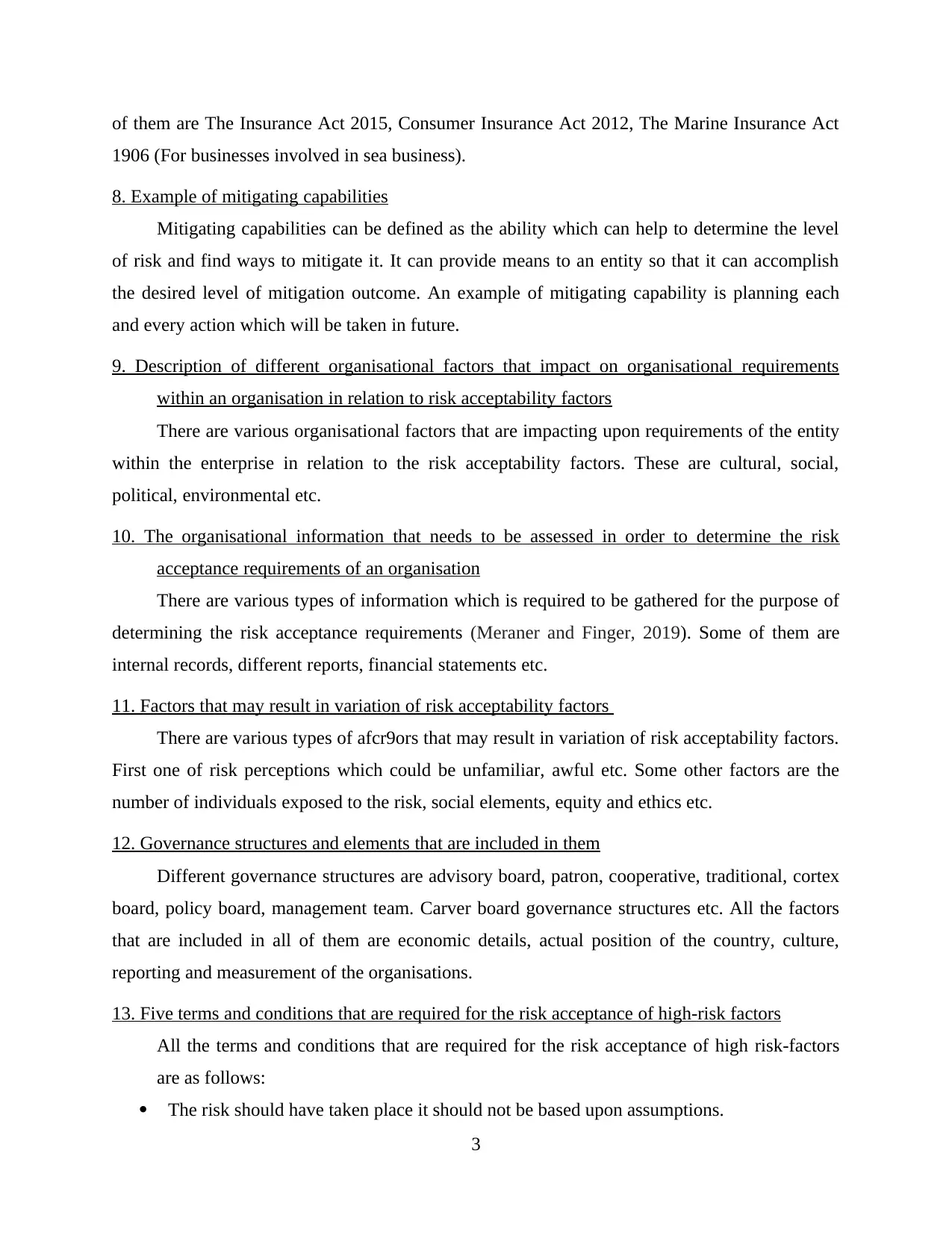
of them are The Insurance Act 2015, Consumer Insurance Act 2012, The Marine Insurance Act
1906 (For businesses involved in sea business).
8. Example of mitigating capabilities
Mitigating capabilities can be defined as the ability which can help to determine the level
of risk and find ways to mitigate it. It can provide means to an entity so that it can accomplish
the desired level of mitigation outcome. An example of mitigating capability is planning each
and every action which will be taken in future.
9. Description of different organisational factors that impact on organisational requirements
within an organisation in relation to risk acceptability factors
There are various organisational factors that are impacting upon requirements of the entity
within the enterprise in relation to the risk acceptability factors. These are cultural, social,
political, environmental etc.
10. The organisational information that needs to be assessed in order to determine the risk
acceptance requirements of an organisation
There are various types of information which is required to be gathered for the purpose of
determining the risk acceptance requirements (Meraner and Finger, 2019). Some of them are
internal records, different reports, financial statements etc.
11. Factors that may result in variation of risk acceptability factors
There are various types of afcr9ors that may result in variation of risk acceptability factors.
First one of risk perceptions which could be unfamiliar, awful etc. Some other factors are the
number of individuals exposed to the risk, social elements, equity and ethics etc.
12. Governance structures and elements that are included in them
Different governance structures are advisory board, patron, cooperative, traditional, cortex
board, policy board, management team. Carver board governance structures etc. All the factors
that are included in all of them are economic details, actual position of the country, culture,
reporting and measurement of the organisations.
13. Five terms and conditions that are required for the risk acceptance of high-risk factors
All the terms and conditions that are required for the risk acceptance of high risk-factors
are as follows:
The risk should have taken place it should not be based upon assumptions.
3
1906 (For businesses involved in sea business).
8. Example of mitigating capabilities
Mitigating capabilities can be defined as the ability which can help to determine the level
of risk and find ways to mitigate it. It can provide means to an entity so that it can accomplish
the desired level of mitigation outcome. An example of mitigating capability is planning each
and every action which will be taken in future.
9. Description of different organisational factors that impact on organisational requirements
within an organisation in relation to risk acceptability factors
There are various organisational factors that are impacting upon requirements of the entity
within the enterprise in relation to the risk acceptability factors. These are cultural, social,
political, environmental etc.
10. The organisational information that needs to be assessed in order to determine the risk
acceptance requirements of an organisation
There are various types of information which is required to be gathered for the purpose of
determining the risk acceptance requirements (Meraner and Finger, 2019). Some of them are
internal records, different reports, financial statements etc.
11. Factors that may result in variation of risk acceptability factors
There are various types of afcr9ors that may result in variation of risk acceptability factors.
First one of risk perceptions which could be unfamiliar, awful etc. Some other factors are the
number of individuals exposed to the risk, social elements, equity and ethics etc.
12. Governance structures and elements that are included in them
Different governance structures are advisory board, patron, cooperative, traditional, cortex
board, policy board, management team. Carver board governance structures etc. All the factors
that are included in all of them are economic details, actual position of the country, culture,
reporting and measurement of the organisations.
13. Five terms and conditions that are required for the risk acceptance of high-risk factors
All the terms and conditions that are required for the risk acceptance of high risk-factors
are as follows:
The risk should have taken place it should not be based upon assumptions.
3
⊘ This is a preview!⊘
Do you want full access?
Subscribe today to unlock all pages.

Trusted by 1+ million students worldwide
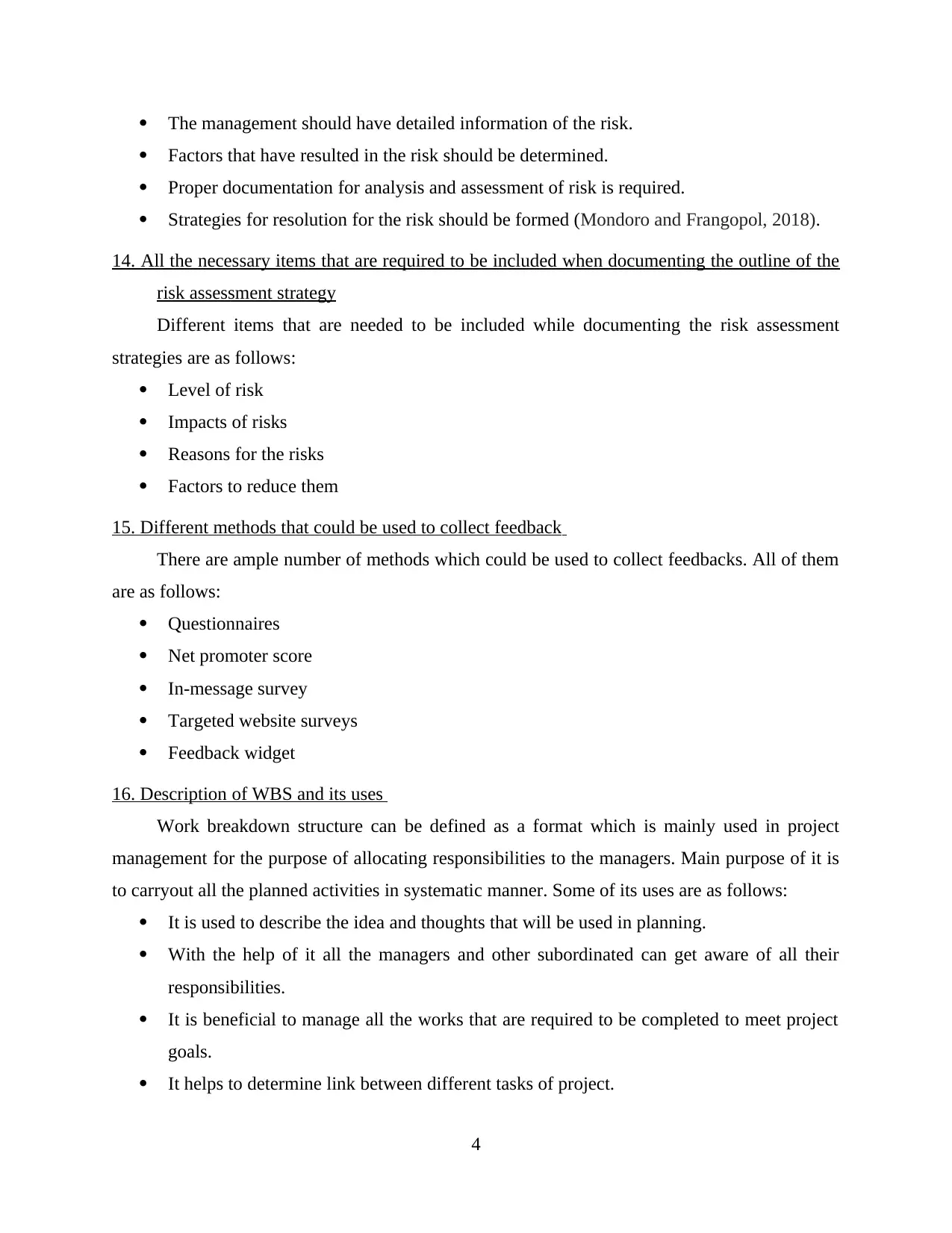
The management should have detailed information of the risk.
Factors that have resulted in the risk should be determined.
Proper documentation for analysis and assessment of risk is required.
Strategies for resolution for the risk should be formed (Mondoro and Frangopol, 2018).
14. All the necessary items that are required to be included when documenting the outline of the
risk assessment strategy
Different items that are needed to be included while documenting the risk assessment
strategies are as follows:
Level of risk
Impacts of risks
Reasons for the risks
Factors to reduce them
15. Different methods that could be used to collect feedback
There are ample number of methods which could be used to collect feedbacks. All of them
are as follows:
Questionnaires
Net promoter score
In-message survey
Targeted website surveys
Feedback widget
16. Description of WBS and its uses
Work breakdown structure can be defined as a format which is mainly used in project
management for the purpose of allocating responsibilities to the managers. Main purpose of it is
to carryout all the planned activities in systematic manner. Some of its uses are as follows:
It is used to describe the idea and thoughts that will be used in planning.
With the help of it all the managers and other subordinated can get aware of all their
responsibilities.
It is beneficial to manage all the works that are required to be completed to meet project
goals.
It helps to determine link between different tasks of project.
4
Factors that have resulted in the risk should be determined.
Proper documentation for analysis and assessment of risk is required.
Strategies for resolution for the risk should be formed (Mondoro and Frangopol, 2018).
14. All the necessary items that are required to be included when documenting the outline of the
risk assessment strategy
Different items that are needed to be included while documenting the risk assessment
strategies are as follows:
Level of risk
Impacts of risks
Reasons for the risks
Factors to reduce them
15. Different methods that could be used to collect feedback
There are ample number of methods which could be used to collect feedbacks. All of them
are as follows:
Questionnaires
Net promoter score
In-message survey
Targeted website surveys
Feedback widget
16. Description of WBS and its uses
Work breakdown structure can be defined as a format which is mainly used in project
management for the purpose of allocating responsibilities to the managers. Main purpose of it is
to carryout all the planned activities in systematic manner. Some of its uses are as follows:
It is used to describe the idea and thoughts that will be used in planning.
With the help of it all the managers and other subordinated can get aware of all their
responsibilities.
It is beneficial to manage all the works that are required to be completed to meet project
goals.
It helps to determine link between different tasks of project.
4
Paraphrase This Document
Need a fresh take? Get an instant paraphrase of this document with our AI Paraphraser
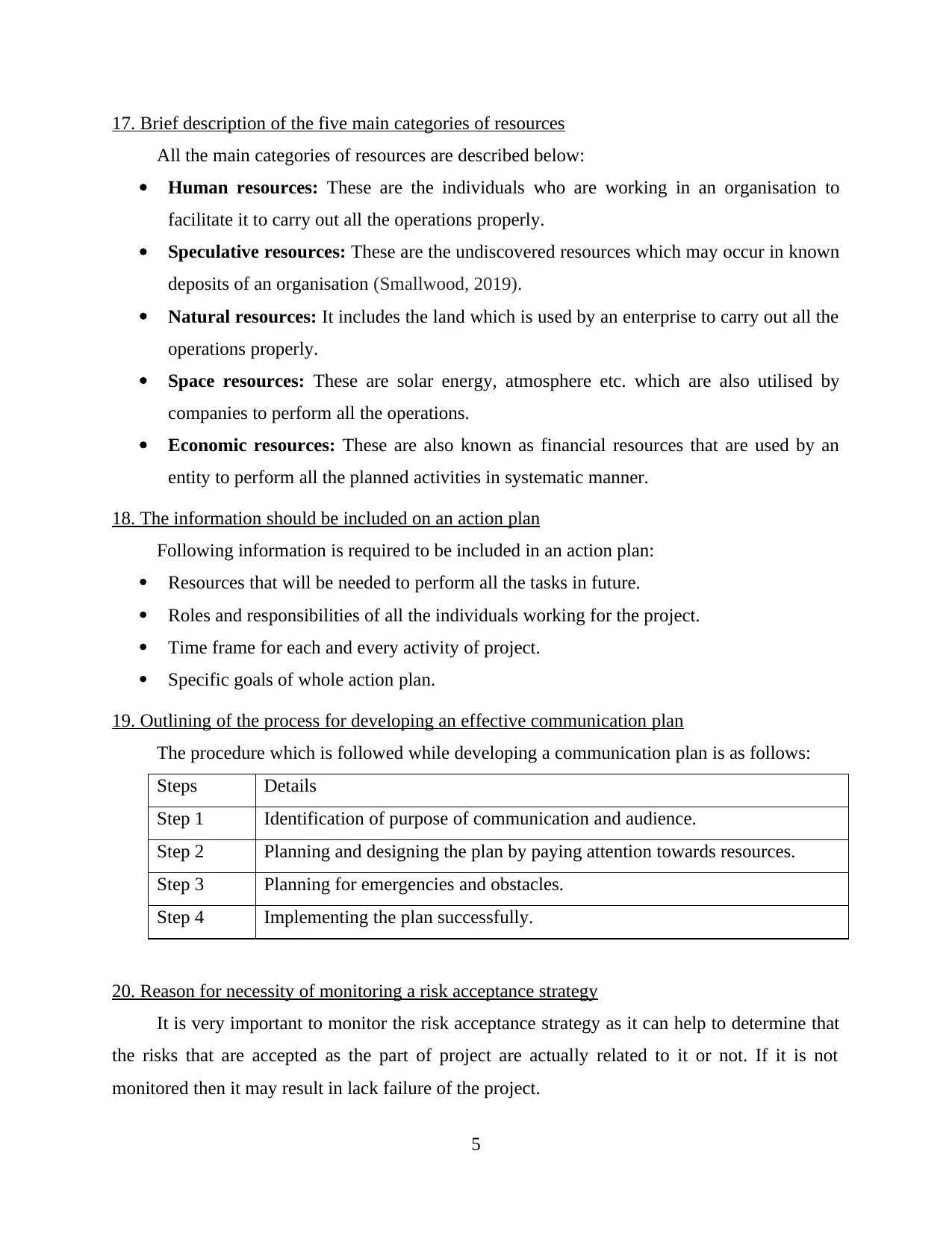
17. Brief description of the five main categories of resources
All the main categories of resources are described below:
Human resources: These are the individuals who are working in an organisation to
facilitate it to carry out all the operations properly.
Speculative resources: These are the undiscovered resources which may occur in known
deposits of an organisation (Smallwood, 2019).
Natural resources: It includes the land which is used by an enterprise to carry out all the
operations properly.
Space resources: These are solar energy, atmosphere etc. which are also utilised by
companies to perform all the operations.
Economic resources: These are also known as financial resources that are used by an
entity to perform all the planned activities in systematic manner.
18. The information should be included on an action plan
Following information is required to be included in an action plan:
Resources that will be needed to perform all the tasks in future.
Roles and responsibilities of all the individuals working for the project.
Time frame for each and every activity of project.
Specific goals of whole action plan.
19. Outlining of the process for developing an effective communication plan
The procedure which is followed while developing a communication plan is as follows:
Steps Details
Step 1 Identification of purpose of communication and audience.
Step 2 Planning and designing the plan by paying attention towards resources.
Step 3 Planning for emergencies and obstacles.
Step 4 Implementing the plan successfully.
20. Reason for necessity of monitoring a risk acceptance strategy
It is very important to monitor the risk acceptance strategy as it can help to determine that
the risks that are accepted as the part of project are actually related to it or not. If it is not
monitored then it may result in lack failure of the project.
5
All the main categories of resources are described below:
Human resources: These are the individuals who are working in an organisation to
facilitate it to carry out all the operations properly.
Speculative resources: These are the undiscovered resources which may occur in known
deposits of an organisation (Smallwood, 2019).
Natural resources: It includes the land which is used by an enterprise to carry out all the
operations properly.
Space resources: These are solar energy, atmosphere etc. which are also utilised by
companies to perform all the operations.
Economic resources: These are also known as financial resources that are used by an
entity to perform all the planned activities in systematic manner.
18. The information should be included on an action plan
Following information is required to be included in an action plan:
Resources that will be needed to perform all the tasks in future.
Roles and responsibilities of all the individuals working for the project.
Time frame for each and every activity of project.
Specific goals of whole action plan.
19. Outlining of the process for developing an effective communication plan
The procedure which is followed while developing a communication plan is as follows:
Steps Details
Step 1 Identification of purpose of communication and audience.
Step 2 Planning and designing the plan by paying attention towards resources.
Step 3 Planning for emergencies and obstacles.
Step 4 Implementing the plan successfully.
20. Reason for necessity of monitoring a risk acceptance strategy
It is very important to monitor the risk acceptance strategy as it can help to determine that
the risks that are accepted as the part of project are actually related to it or not. If it is not
monitored then it may result in lack failure of the project.
5
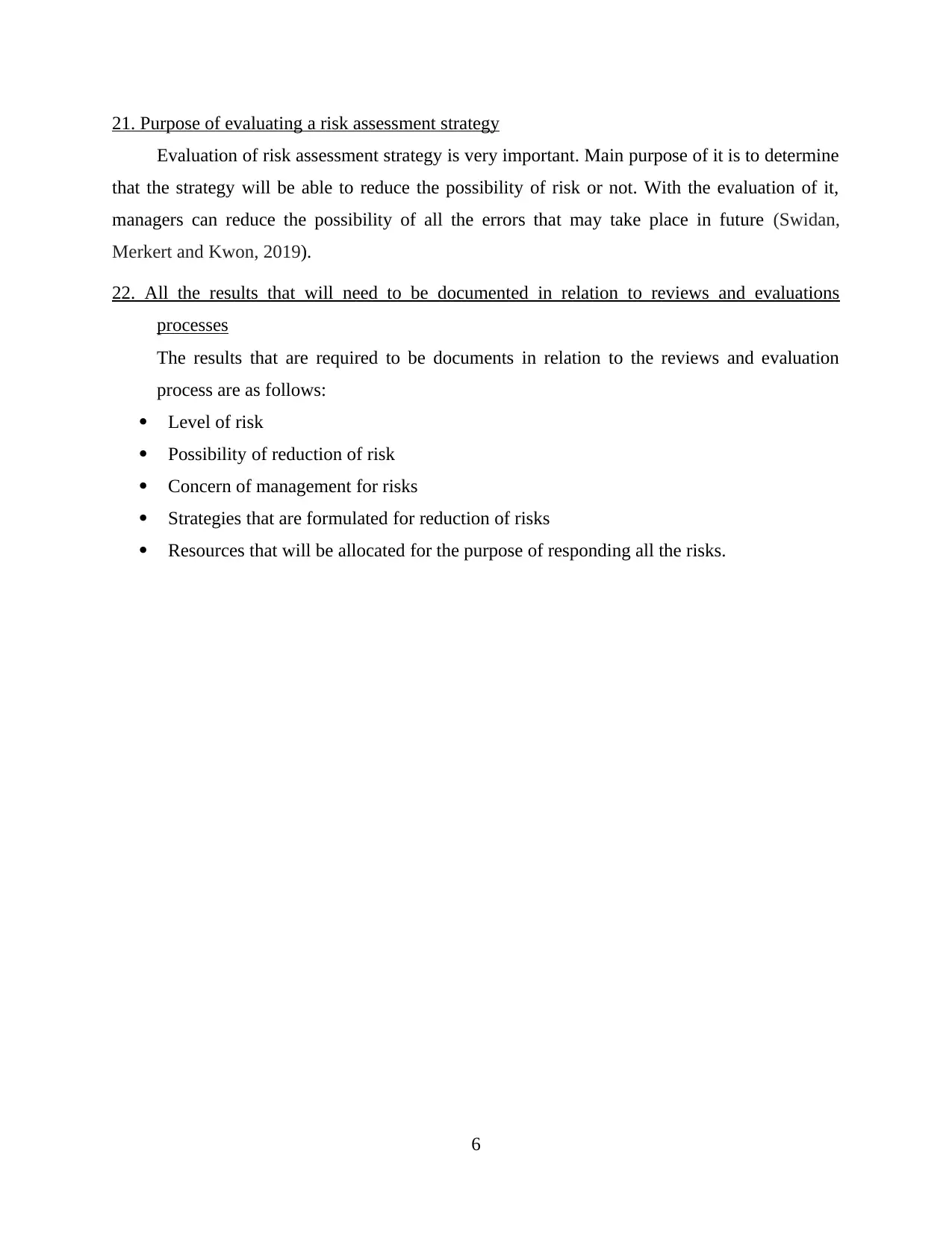
21. Purpose of evaluating a risk assessment strategy
Evaluation of risk assessment strategy is very important. Main purpose of it is to determine
that the strategy will be able to reduce the possibility of risk or not. With the evaluation of it,
managers can reduce the possibility of all the errors that may take place in future (Swidan,
Merkert and Kwon, 2019).
22. All the results that will need to be documented in relation to reviews and evaluations
processes
The results that are required to be documents in relation to the reviews and evaluation
process are as follows:
Level of risk
Possibility of reduction of risk
Concern of management for risks
Strategies that are formulated for reduction of risks
Resources that will be allocated for the purpose of responding all the risks.
6
Evaluation of risk assessment strategy is very important. Main purpose of it is to determine
that the strategy will be able to reduce the possibility of risk or not. With the evaluation of it,
managers can reduce the possibility of all the errors that may take place in future (Swidan,
Merkert and Kwon, 2019).
22. All the results that will need to be documented in relation to reviews and evaluations
processes
The results that are required to be documents in relation to the reviews and evaluation
process are as follows:
Level of risk
Possibility of reduction of risk
Concern of management for risks
Strategies that are formulated for reduction of risks
Resources that will be allocated for the purpose of responding all the risks.
6
⊘ This is a preview!⊘
Do you want full access?
Subscribe today to unlock all pages.

Trusted by 1+ million students worldwide
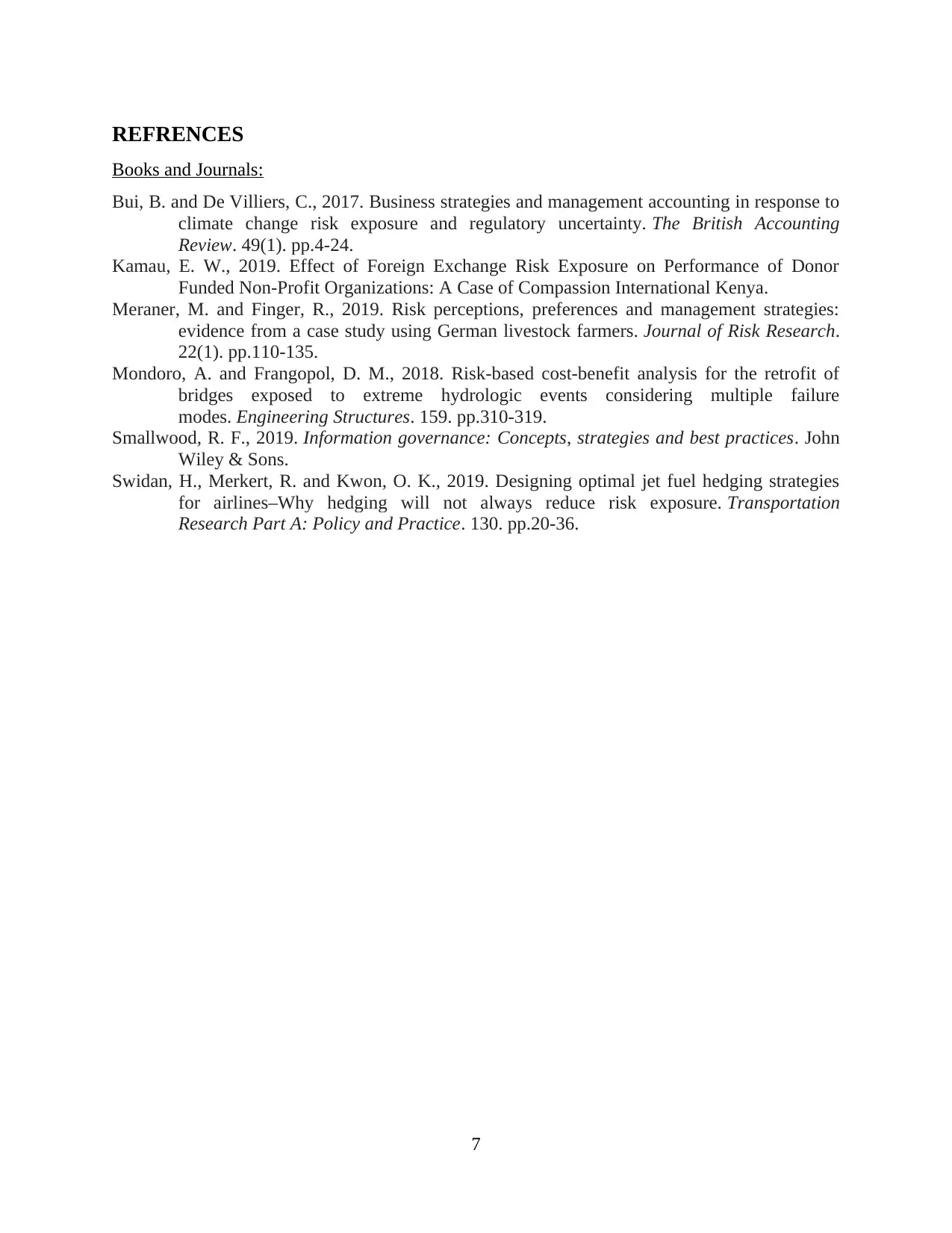
REFRENCES
Books and Journals:
Bui, B. and De Villiers, C., 2017. Business strategies and management accounting in response to
climate change risk exposure and regulatory uncertainty. The British Accounting
Review. 49(1). pp.4-24.
Kamau, E. W., 2019. Effect of Foreign Exchange Risk Exposure on Performance of Donor
Funded Non-Profit Organizations: A Case of Compassion International Kenya.
Meraner, M. and Finger, R., 2019. Risk perceptions, preferences and management strategies:
evidence from a case study using German livestock farmers. Journal of Risk Research.
22(1). pp.110-135.
Mondoro, A. and Frangopol, D. M., 2018. Risk-based cost-benefit analysis for the retrofit of
bridges exposed to extreme hydrologic events considering multiple failure
modes. Engineering Structures. 159. pp.310-319.
Smallwood, R. F., 2019. Information governance: Concepts, strategies and best practices. John
Wiley & Sons.
Swidan, H., Merkert, R. and Kwon, O. K., 2019. Designing optimal jet fuel hedging strategies
for airlines–Why hedging will not always reduce risk exposure. Transportation
Research Part A: Policy and Practice. 130. pp.20-36.
7
Books and Journals:
Bui, B. and De Villiers, C., 2017. Business strategies and management accounting in response to
climate change risk exposure and regulatory uncertainty. The British Accounting
Review. 49(1). pp.4-24.
Kamau, E. W., 2019. Effect of Foreign Exchange Risk Exposure on Performance of Donor
Funded Non-Profit Organizations: A Case of Compassion International Kenya.
Meraner, M. and Finger, R., 2019. Risk perceptions, preferences and management strategies:
evidence from a case study using German livestock farmers. Journal of Risk Research.
22(1). pp.110-135.
Mondoro, A. and Frangopol, D. M., 2018. Risk-based cost-benefit analysis for the retrofit of
bridges exposed to extreme hydrologic events considering multiple failure
modes. Engineering Structures. 159. pp.310-319.
Smallwood, R. F., 2019. Information governance: Concepts, strategies and best practices. John
Wiley & Sons.
Swidan, H., Merkert, R. and Kwon, O. K., 2019. Designing optimal jet fuel hedging strategies
for airlines–Why hedging will not always reduce risk exposure. Transportation
Research Part A: Policy and Practice. 130. pp.20-36.
7
1 out of 10
Related Documents
Your All-in-One AI-Powered Toolkit for Academic Success.
+13062052269
info@desklib.com
Available 24*7 on WhatsApp / Email
![[object Object]](/_next/static/media/star-bottom.7253800d.svg)
Unlock your academic potential
Copyright © 2020–2025 A2Z Services. All Rights Reserved. Developed and managed by ZUCOL.



